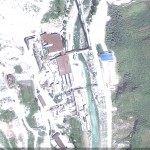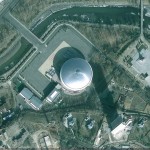UPDATE 2 (2011-4-11): South Korea has declared the move illegal. According to the AFP:
South Korea Monday criticised North Korea’s threat to strip a Seoul firm of its exclusive right to run tours to a mountain resort in the communist state, calling the move illegal and unacceptable.
The North said Saturday it may deprive Hyundai Asan of its monopoly over tours to scenic Mount Kumgang, where the firm has invested millions of dollars and has a 50-year agreement reached in 2000.
“The North’s claim… is in violation of agreements made at business and government levels as well as international customs,” said Chun Hae-Sung, a spokesman for the South’s unification ministry that handles cross-border affairs.
“The decision is absolutely illegal, illegitimate and unacceptable and should be withdrawn immediately,” Chun said.
UPDATE 1 (2011-4-11): The DPRK has formally ended Hyundai’s contract. According to the Choson Ilbo:
North Korea has unilaterally ended a long-standing agreement that gave South Korea’s Hyundai Asan the sole rights to operate package tours to Mt. Kumgang. The tours have long been suspended, but Hyundai Asan has put a significant amount of money into accommodation and other infrastructure in the scenic resort.
In a statement on Friday night, the North’s Asia-Pacific Peace Committee said, “We’re invalidating the clause on the exclusive right given to Hyundai in the agreement on Mt. Kumgang tourism that we concluded with the company.” It said Hyundai Asan may continue to operate tours from the South Korean side, but the committee “will take care of the tours arranged through the North Korean side.”
A Hyundai Asan spokesman said the following day North Korea should withdraw the decision “since no terms of the agreement can be canceled or invalidated unilaterally by either side.”
Unilateral Decision
The two sides signed an agreement in October 1998 giving Hyundai Asan, a subsidiary of the Hyundai Corporation not to be confused with Hyundai Motor Group, the exclusive right to operate the tours.
In 2002, the regime granted Hyundai Asan the right to use of land in the Mt. Kumgang area until 2052, but it confiscated the property after South Korea suspended the tours following the shooting death of a tourist in July 2008.
According to Hyundai Asan, North Korean officials summoned staff to Mt. Kumgang on March 15 and 30 and told them the North would now promote tours on its own. On March 30, the North Korean also proffered a written document to a Hyundai Asan staffer, who refused to accept it saying it contravenes the original agreement.
The decision to cancel the deal nonetheless shows how desperate the North is to earn hard currency, since the apparent aim is to promote tours for Chinese visitors instead or indirectly pressure the South Korean government into resuming the tours.
Seoul says it will not resume the tours until the North allows an investigation of the shooting, gives firm safety guarantees, and promises to prevent similar incidents. There have been talks about their resumption, but the North’s sinking of the Navy corvette Cheonan in March last year and shelling of Yeonpyeong Island in November effectively strangled them at birth.
Chinese Tourists
It is unlikely that the North can plug the gap with revenues from Chinese tourists. Hyundai Asan says about 1.96 million tourists visited Mt. Kumgang over the past 10-odd years, but a mere 12,000 came from countries other than South Korea.
It remains to be seen whether the North will use the Hyundai-owned facilities to accommodate Chinese visitors.
Hyundai Asan has spent a total of W754.1 billion (US$1=W1,084) on developing nearby land and building facilities such as a power plant and a hotel. Other South Korean agencies and companies, including the Korea Tourism Organization and the National Agricultural Cooperative Federation, invested W133 billion. After tours were suspended, Hyundai Asan left 16 staffers behind at Mt. Kumgang to look after its properties.
ORIGINAL POST (2011-4-9): According to Yonhap:
Apparently growing impatient with South Korea’s lukewarm response to its dialogue offer, North Korea announced Friday that it could terminate an exclusive contract with a South Korean conglomerate for tourism at Mount Kumgang, a resort along its east coast.
In a statement carried by the official news agency KCNA, the Asia Pacific Peace Committee, a state organ in charge of inter-Korean relations, said, “There is no more prospect of resuming the tour of Mount Kumgang.”
“In this regard it informed the Hyundai side of its stand that it may terminate the validity of the provision of the agreement on tour of Mount Kumgang signed with the Hyundai side which calls for granting it monopoly over the tour,” it said, referring to Hyundai Asan, the South Korean operator of Mount Kumgang tourism program.
The statement also added Hyundai could continue conducting tours for South Koreans but that Pyongyang “may” take charge of tours to Mount Kumgang and elsewhere for North Koreans and also entrust an overseas business professional with such tours.
South Koreans’ tours to Mount Kumgang, once a cash cow for the impoverished North, have been suspended since the summer of 2008, when a female South Korean tourist was shot dead after straying into an off-limits military zone.
Pyongyang has been seeking to resume the joint venture, but Seoul has demanded a formal apology for the killing of the housewife, along with measures to prevent a recurrence of such an incident and a guarantee of tourists’ safety.
Friday’s announcement was viewed as aimed at putting pressure on the South to restart the tourism business.
Hyundai Asan said it was working to identify North Korea’s true intentions.
“The company is working to find out at the earliest possible date what the North’s true intentions are,” a Hyundai Asan official said, asking not to be identified.
North Korea froze Hyundai Asan’s assets at Mount Kumgang last year in an apparent attempt to pressure South Korea to resume tours to the mountain, a spiritual destination for Koreans on both sides of the border.
After years of threats and provocative acts, highlighted by two deadly attacks in 2010, Pyongyang has been appealing to Seoul for talks. Conservatives here say the North wants aid from the South and a dialogue with the United States.
Here you can see more of Seoul’s demands for resuming Kumgang tours.
Here and here you can find more information on Seoul’s demands for resuming Kumgang Tours.
Previous posts about the Kumgang Resort can be found here.


